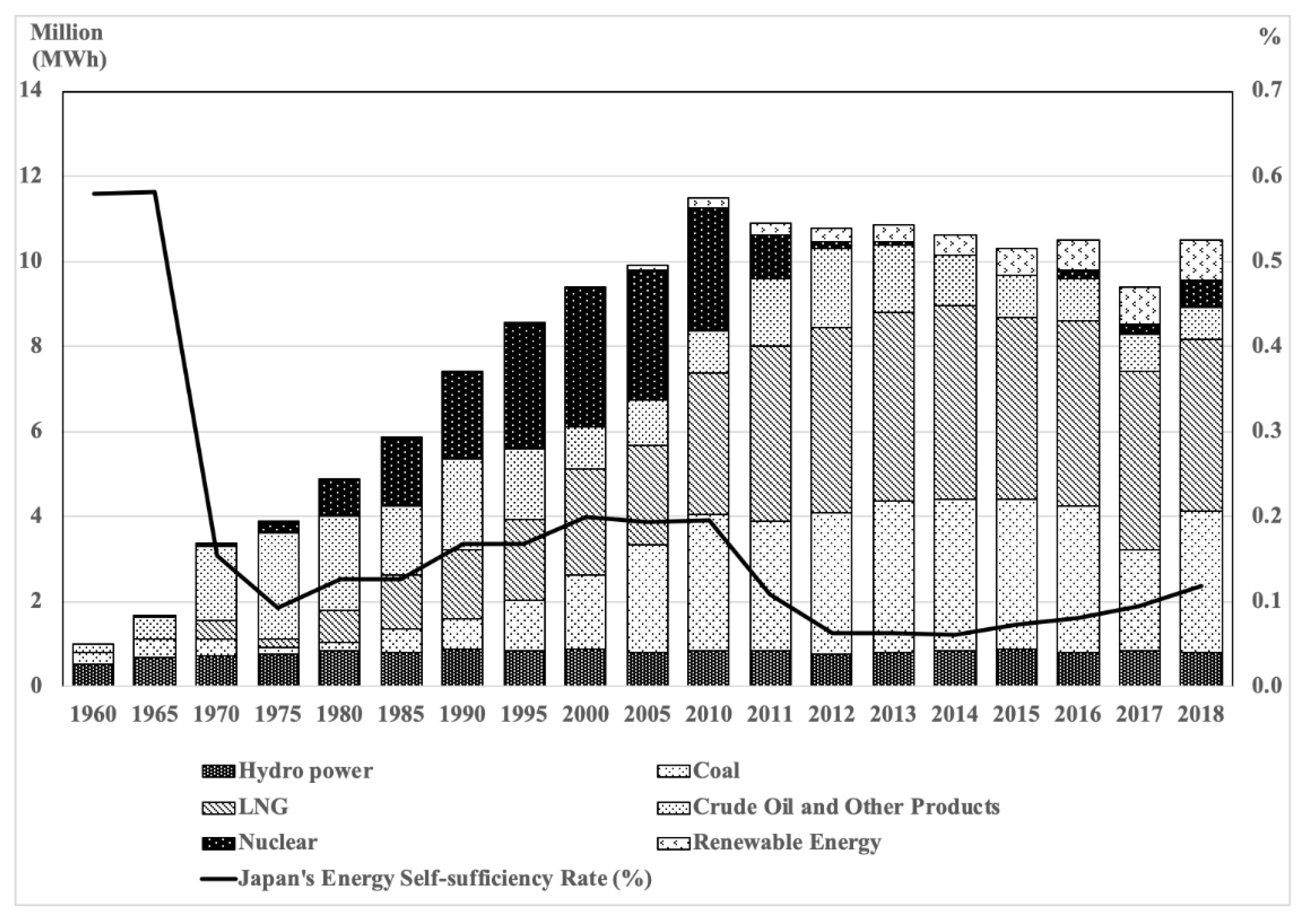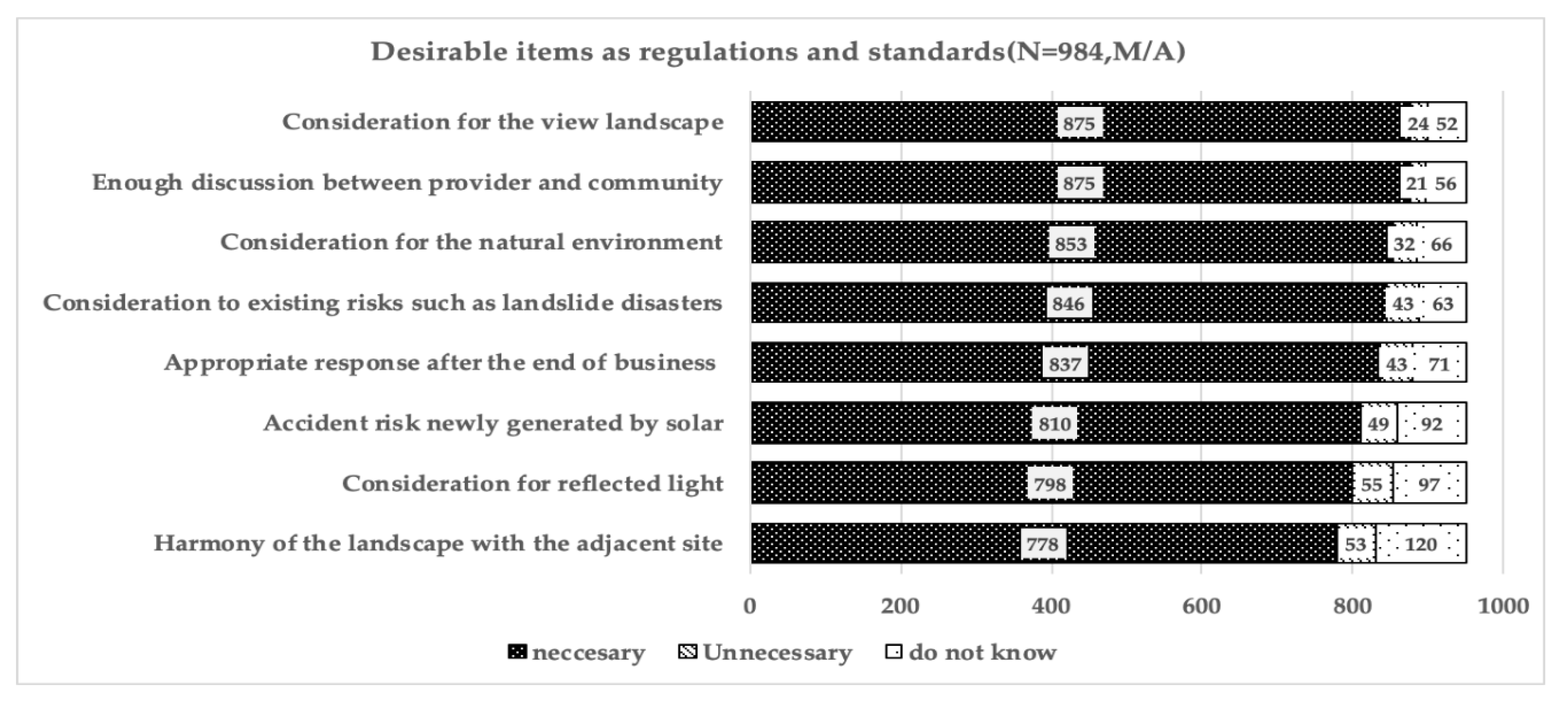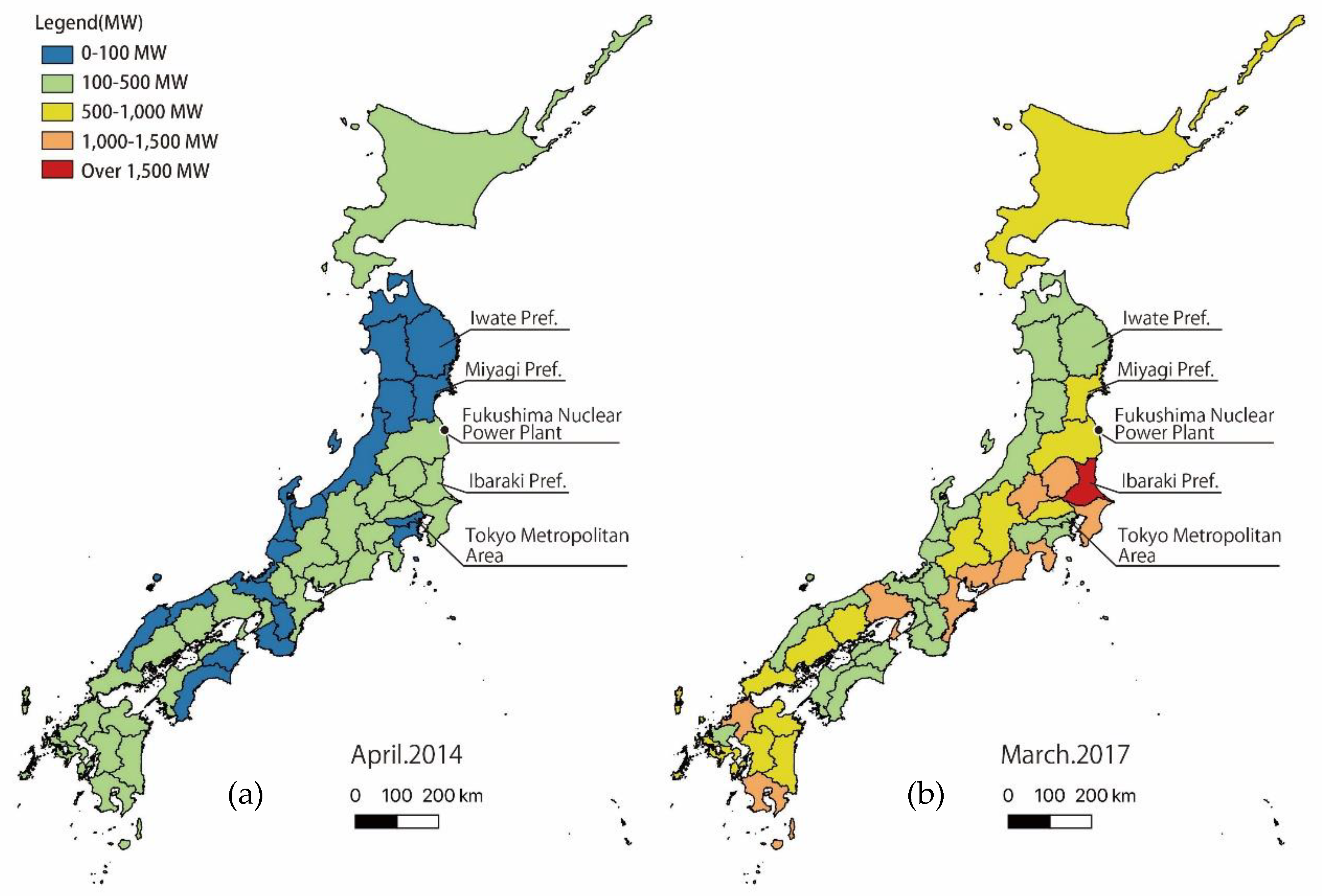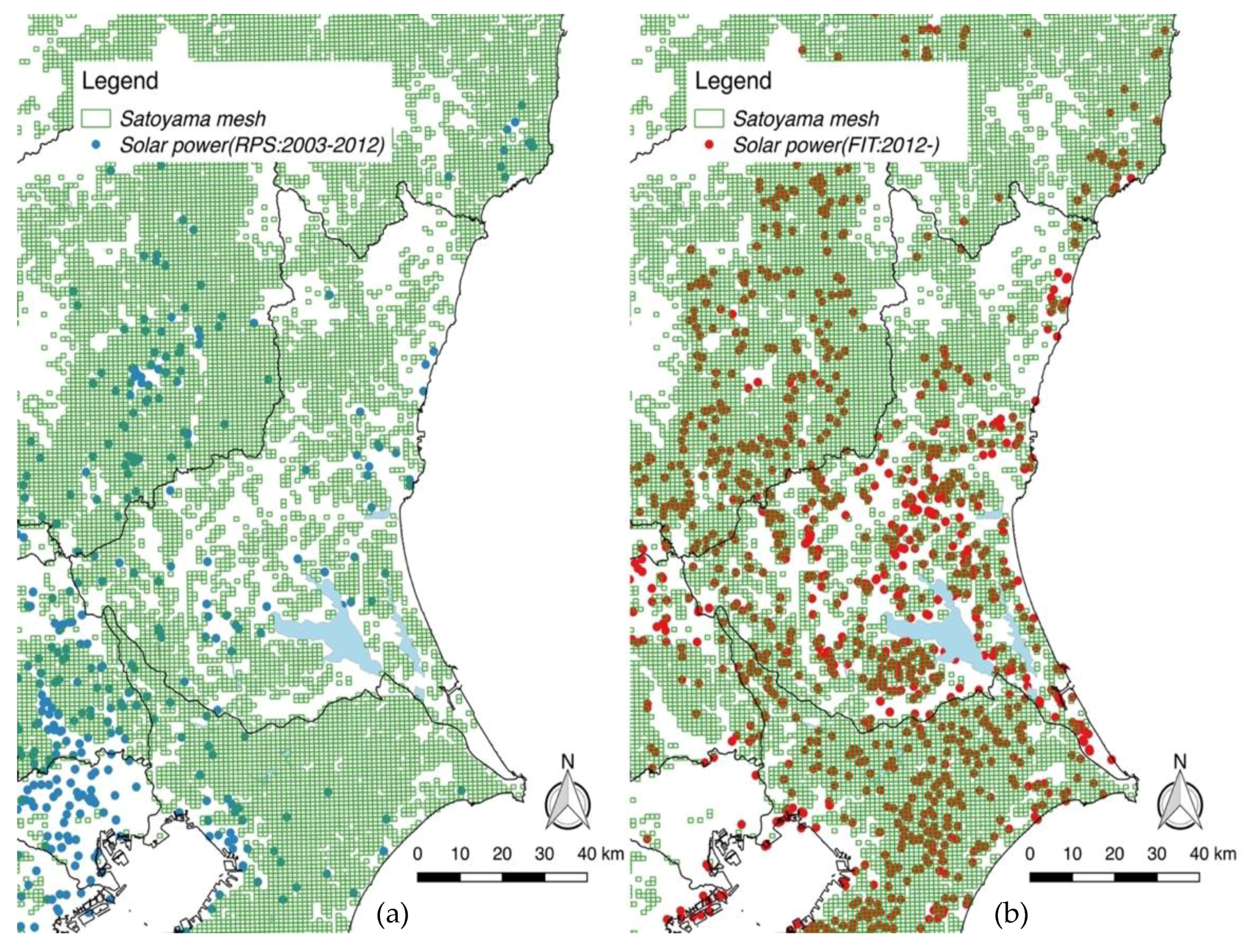Managing Conflicts with Local Communities over the Introduction of Renewable Energy: The Solar-Rush Experience in Japan
Abstract
:1. Introduction
2. Literature Review
3. Trends in Energy in Japan
4. Materials and Methods: Survey Design and Implementation
4.1. Methodology
4.2. Data Collection
4.2.1. Qualitative Survey with Questionnaires and Interviews of the Local Governments
4.2.2. Quantitative Survey through Analysis of Change in Location of Solar Power in Japan
- (1)
- RPS data
- (a)
- Extract the “solar power” data from the “power generation facility” data of the Digital National Land Information database.
- (b)
- Calculate the data with a valid “RPS certification date” (excluding data such as 9999).
- (c)
- As a result, 2362 solar power facilities were extracted nationwide (certification years from 2003 to 2012).
- (2)
- FIT data
- (a)
- Obtained information on the solar power certified by the FIT: facility name, company name, date of certification, amount of power generated, and address of the facility. The data were published by the Ministry of Economy, Trade and Industry as “business plan certification information under the FIT system”.
- (b)
- From “Electric Japan”, we extracted the facility name, company name, and amount of power generated by solar power that is operating under the FIT system.
- (c)
- Match the information in (a) with the information in (b) and extract the information that matches the facility name, company name, and amount of power generated.
- (d)
- Obtain the extracted facility address of (c) from data of the Ministry of Economy, Trade and Industry and convert it to GIS location information.
- (e)
- Obtain data on the location of the 7970 solar power facilities in operation.
- (3)
- Data for the Ibaraki Prefecture
4.3. Data Analyses
5. Results
5.1. Issues for Local Communities
5.1.1. Items Recognized as Issues
5.1.2. Required Regulations
5.2. Changes in Characteristics of the Location of Solar Power Facilities
5.2.1. Overview of Changes in the Location of Solar Power Facilities between RPS and FIT
5.2.2. Areas Where Solar Power Is Concentrated
5.3. Case Study on the Ibaraki Prefecture
6. Discussion: Conflict Management
7. Conclusions
Author Contributions
Funding
Conflicts of Interest
References
- Semeraro, T.; Aretano, R.; Barca, A.; Pomes, A.; Giudice, C.D.; Gatto, E.; Lenucci, M.; Buccolieri, R.; Emmanuel, R.; Gao, A.; et al. A conceptual framework to design green infrastructure: Ecosystem services as an opportunity for creating shared value in ground photovoltaic systems. Land 2020, 9, 238. [Google Scholar] [CrossRef]
- Frolova, M.; Centeri, C.; Benediktsson, K.; Hunziker, M.; Kabai, R.; Scognamiglio, A.; Martinopoulos, G.; Sismani, G.; Brito, P.; Munoz-ceron, E.; et al. Effects of renewable energy on landscape in Europe: Comparison of hydro, wind, solar, bio-, geothermal and infrastructure energy landscapes. Hung. Geogr. Bull. 2019, 68, 317–333. [Google Scholar] [CrossRef]
- REN21. Renewables 2020 Global Status Report. Available online: https://www.ren21.net/wp-content/uploads/2019/05/gsr_2020_full_report_en.pdf (accessed on 31 May 2020).
- Nascimento, F.M.; Siluk, J.C.M.; Savian, F.S.; Garlet, T.B.; Pinheiro, J.R.; Ramos, C. Factors for measuring photovoltaic adoption from the perspective of operators. Sustainability 2020, 12, 3184. [Google Scholar] [CrossRef] [Green Version]
- Garlet, T.B.; Ribeiro, J.L.D.; Savian, F.S.; Siluk, J.C.M. Paths and barriers to the diffusion of distributed generation of photovoltaic energy in southern Brazil. Renew. Sustain. Energy Rev. 2019, 111, 157–169. [Google Scholar] [CrossRef]
- Urmee, T.; Walker, E.; Bahri, P.A.; Baverstock, G.; Rezvani, S.; Sama, W. Solar water heaters uptake in Australia—Issues and barriers. Sustain. Energy Technol. Assess. 2018, 30, 11–23. [Google Scholar] [CrossRef]
- Nikas, A.; Neofytou, H.; Karamaneas, A.; Koasidis, K.; Psarras, J. Sustainable and socially just transition to a postlignite era in Greece: A multi-level perspective. Energy Sources Part B Econ. Plan. Policy 2020, 1–32. [Google Scholar] [CrossRef]
- Jong, J.; Stremke, S. Evolution of energy landscapes: A regional case study in the western Netherlands. Sustainability 2020, 12, 4554. [Google Scholar] [CrossRef]
- Jeremy, F.; Willett, K. Public opinion about large offshore wind power: Underlying factors. Energy Policy 2007, 35, 1584–1598. [Google Scholar]
- Cicia, G.; Cembalo, L.; Del Giudice, T.; Palladino, A. Fossil energy versus nuclear, wind, solar and agricultural biomass: Insights from an Italian national survey. Energy Policy 2012, 42, 59–66. [Google Scholar] [CrossRef]
- Delicado, A.; Figueiredo, E.; Silva, L. Community perceptions of renewable energies in Portugal: Impacts on environment landscape and local development. Energy Res. Soc. Sci. 2016, 13, 84–93. [Google Scholar] [CrossRef]
- Dear, M. Understanding and overcoming the NIMBY syndrome. APAJ 1992, 58, 288–300. [Google Scholar] [CrossRef]
- Bell, D.; Gray, T.; Haggett, C. The ‘social gap’ in wind farm siting decisions: Explanations and policy responses. Environ. Politics 2005, 14, 460–477. [Google Scholar] [CrossRef]
- Van der Horst, D. NMNBY or not? Exploring the relevance of location and the politics of voiced opinions in renewable energy siting controversies. Energy Policy 2007, 35, 2705–2714. [Google Scholar] [CrossRef] [Green Version]
- Wustenhagen, R.; Wolsink, M.; Burer, M.J. Social acceptance of renewable energy innovation: An introduction to the concept. Energy Policy 2007, 25, 2683–2691. [Google Scholar] [CrossRef] [Green Version]
- D’Souza, C.; Yiridoe, E.K. Social acceptance of wind energy development and planning in rural communities of Australia: A consumer analysis. Energy Policy 2014, 74, 262–270. [Google Scholar] [CrossRef]
- Simcock, N. Procedural justice and the implementation of community wind energy projects: A case study from South Yorkshire, UK. Land Use Policy 2016, 59, 467–477. [Google Scholar] [CrossRef] [Green Version]
- Prados, M.J. Renewable energy policy and landscape management in Andalusia, Spain: The facts. Energy Policy 2010, 38, 6900–6909. [Google Scholar] [CrossRef]
- Pasqualetti, M.J. Social Barriers to Renewable Energy Landscapes. Geogr. Rev. 2011, 101, 201–223. [Google Scholar] [CrossRef]
- Hernandez, R.R.; Hoffacker, M.K.; Field, C.B. Efficient use of land to meet sustainable energy needs. Nat. Clim. Chang. 2015, 5, 353–358. [Google Scholar] [CrossRef]
- Torres-Sibille, A.D.; Cloquell-Ballester, V.A.; Ramirez, M.A.A. Aesthetic impact assessment of solar power plants: An objective and a subjective approach. Renew. Sustain. Energy Rev. 2009, 13–15, 986–999. [Google Scholar] [CrossRef]
- Scognamiglio, A. ‘Photovoltaic landscapes’: Design and assessment. A critical review for a new transdisciplinary design vision. Renew. Sustain. Energy Rev. 2016, 55, 629–661. [Google Scholar] [CrossRef]
- Rodrigues, M.; Montanes, C.; Fueyo, N. A method for the assessment of the visual impact caused by the large-scale deployment of renewable-energy facilities. Environ. Impact Assess. Rev. 2010, 30, 240–246. [Google Scholar] [CrossRef]
- Bevk, T.; Golobič, M. Contentious eye-catchers: Perceptions of landscapes changed by solar power plants in Slovenia. Renew. Energy 2020, 152, 999–1010. [Google Scholar] [CrossRef]
- Moreno-Jiménez, A.; Cañada-Torrecilla, R.; Vidal-Domínguez, M.J.; Palacios-García, A.; Martínez-Suáre, P. Assessing environmental justice through potential exposure to air pollution: A socio-spatial analysis in Madrid and Barcelona, Spain. Geoforum 2016, 69, 117–131. [Google Scholar] [CrossRef]
- Magnani, N.; Carrosio, G.; Osti, G. Energy retrofitting of urban buildings: A socio-spatial analysis of three mid-sized Italian cities. Energy Policy 2020, 139, 111341. [Google Scholar] [CrossRef]
- Liu, Y.; Cheshire, L.; Wang, S.; Fu, X. A socio-spatial analysis of neighbour complaints using large-scale administrative data: The case in Brisbane, Australia. Cities 2019, 90, 168–180. [Google Scholar] [CrossRef]
- Koura, H.; Akizuki, H. Planning Issues in the Conflicting Public Interests of Landscape and Renewable Energy-Measures against the Impact of Large-scale Solar Power Plant in the Shimanto River Cultural Landscape Conservation. J. City Plan. Inst. Jpn. 2017, 52, 1171–1176. [Google Scholar]
- Suzuki, K. Preface for a Better Understanding of Environmental Conflict over the Renewable Energy Facility-Siting. J. Interdiscip. Res. Community Life 2016, 7, 39–41. [Google Scholar] [CrossRef]
- Sakamura, K.; Kaneko, T.; Numata, M.; Nakai, N. Study on the site character of the ground standing Photovoltaic Power Generating System. J. City Plan. Inst. Jpn. 2014, 49, 633–638. [Google Scholar]
- Akita, N. A study on the Actual Conditions of Community Based Planning through the Machizukuri Ordinance: Case Study on the Machizukuri Organizations by Kobe-city Machizukuri Ordinance. J. City Plan. Inst. Jpn. 2010, 45, 7–12. [Google Scholar]
- Van der Horst, D.; Vermeylen, S. Local Rights to Landscape in the Global Moral Economy of Carbon. Landsc. Res. 2011, 36, 455–470. [Google Scholar] [CrossRef]
- Munday, M.; Bristow, C.; Cowell, R. Wind farms in rural areas: How far do community benefits from wind farms represent a local economic development opportunity? J. Rural Stud. 2011, 27, 1–12. [Google Scholar] [CrossRef]
- Bergmann, A.; Colombo, S.; Hanley, N. Rural versus urban preferences for renewable energy developments. Ecol. Econ. 2008, 65, 616–625. [Google Scholar] [CrossRef]
- Japan Renewable Energy Policy Platform. Renewables Japan Status Report 2010. Available online: http://www.re-policy.jp/jrepp/JSR2010SMR20101004E.pdf (accessed on 30 May 2020).
- BP. Statistical Review of World Energy. 2011. Available online: http://large.stanford.edu/courses/2011/ph240/waisberg1/docs/bp.pdf (accessed on 30 May 2020).
- Ministry of Economy, Trade and Industry. Agency for Natural Resources and Energy. Energy White Paper 2018; Agency for Natural Resources and Energy: Chiyoda-ku, Tokyo, 2018.
- Institute for Sustainable Energy Policies. Renewables Japan Status Report 2017. Available online: https://www.isep.or.jp/jsr/2017report (accessed on 30 May 2020).
- Tsujimura, C. Focusing on the Issues in Solar Power Facility-Siting in the Light of Biodiversity and Nature Conservation. J. Interdiscip. Res. Community Life 2016, 7, 150–154. [Google Scholar]
- Korenaga, T. Environmental assessment and solar power generation in Nagano Prefecture. Impact Assess. 2018, 16, 27–29. [Google Scholar] [CrossRef]
- Zoellner, J.; Schweizer-Ries, P.; Wemheuer, C. Public acceptance of renewable energies: Results from case studies in Germany. Energy Policy 2008, 36, 4136–4141. [Google Scholar] [CrossRef]
- Devine-Wright, P.; Howes, Y. Disruption to place attachment and the protection of restorative environments: A wind energy case study. J. Environ. Psychol. 2010, 30, 271–280. [Google Scholar] [CrossRef]
- Ministry of Land, Infrastructure, Transport and Tourism, National Land Numerical Information Service Website. Available online: https://nlftp.mlit.go.jp/ksj/ (accessed on 30 May 2020).
- Ministry of Economy, Trade and Industry, Renewable Energy Business Plan Certification Information. Available online: https://www.fit-portal.go.jp/PublicInfo (accessed on 30 May 2020).
- Ministry of Economy, Trade and Industry. Agency for Natural Resources and Energy. Decided to Respond to Solar Power Non-Operation Projects under the FIT System 2018. Available online: https://www.enecho.meti.go.jp/category/saving_and_new/saiene/kaitori/fit_mikado.html (accessed on 30 May 2020).
- Kitamoto, A. Electrical Japan. Available online: http://agora.ex.nii.ac.jp/Earthquake/201103-eastjapan/energy/electrical-japan/ (accessed on 30 May 2020).
- Kitamoto, A. Electrical Japan: Visualization for Situational Awareness on Public Data Archives. J. Jpn. Soc. Digit. Arch. 2019, 3, 295–299. [Google Scholar]
- Kanemoto, Y.; Tokuoka, K. Proposal for Standards of Metropolitan Areas of Japan, Japanese metropolitan area setting standards. J. Appl. Reg. Sci. 2002, 7, 1–15. [Google Scholar]
- Yoshioka, A.; Kadoya, T.; Imai, J.; Washitani, I. Overview of land use pattern of Japanese Archipelago with bio diversity-conscious land use classification and Satoyama Index. Jpn. J. Conserv. Ecol. 2013, 18, 141–156. [Google Scholar]
- Kadoya, T.; Washitani, I. The Satoyama Index: A biodiversity indicator for agricultural landscapes. Agric. Ecosyst. Environ. 2011, 140, 20–26. [Google Scholar] [CrossRef]
- Ministry of Economy, Trade and Industry. Agency for Natural Resources and Energy. Toward Large-Scale Introduction of Renewable Energy—”System Constraint” Problem and Countermeasures 2017. Available online: https://www.enecho.meti.go.jp/about/special/tokushu/saiene/keitouseiyaku.htm (accessed on 31 May 2020).
- Ministry of Agriculture, Forestry and Fisheries. Agricultural Output and Produced Agricultural Income by Prefecture in 2018; Ministry of Agriculture, Forestry and Fisheries: Chiyoda-ku, Tokyo, 2020.
- Wolsink, M. Wind power implementation: The nature of public attitudes: Equity and fairness instead of ‘backyard motives’. Renew. Sustain. Energy Rev. 2007, 11, 1188–1207. [Google Scholar] [CrossRef]
- Walker, G.; Devine-Wright, P.; Hunter, S.; High, H.; Evans, B. Trust and community: Exploring the meanings, contexts and dynamics of community renewable energy. Energy Policy 2010, 38, 2655–2663. [Google Scholar] [CrossRef]
- Warren, C.R.; McFadyen, M. Does community ownership affect public attitudes to wind energy? A case study from south-west Scotland. Land Use Policy 2010, 27, 204–213. [Google Scholar] [CrossRef]
- Naveh, Z. What is holistic landscape ecology? A conceptual introduction. Landsc. Urban Plan. 2000, 50, 7–26. [Google Scholar] [CrossRef]
- Oudes, D.; Stremke, S. Spatial transition analysis: Spatially explicit and evidence-based targets for sustainable energy transition at the local and regional scale. Landsc. Urban Plan. 2018, 169, 1–11. [Google Scholar] [CrossRef]
- Borenstein, S. The private and public economics of renewable electricity generation. J. Econ. Perspect. 2012, 26, 67–92. [Google Scholar] [CrossRef] [Green Version]






| Type | Minimum Purchase Unit (kW) | Purchase Period (year) | Purchase Price (yen/kWh) | |
|---|---|---|---|---|
| 2012 | 2018 | |||
| Solar | 10 | 20 | 40 | 28 |
| Wind | 20 or more | 20 | 22 | 36 |
| offshore | 20 | 20 + tax | 36 + tax | |
| Geothermal | 15,000 or more | 15 | 26 | 40 |
| 15,000 or less | 15 | 26 + tax | 40 + tax | |
| Hydropower | 1000–30,000 | 20 | 24 | 27–20 |
| 200–1000 | 20 | 29 | 29 + tax | |
| 200 or less | 20 | 34 | 34 + tax | |
| Biomass Power | General timber | 20 | 24 | 24 |
| Thinned wood 2000 or less | 20 | 32 | 40 | |
| Thinned wood 2000 or more | 20 | 32 | 32 | |
| Location Places | RPS (2014) | FIT (2017) | |||
|---|---|---|---|---|---|
| Locations | Percentage | Locations | Percentage | ||
| Satoyama areas | Megacity suburbs | 94 | 9.9 | 61 | 1.4 |
| Adjacent to urbanized areas (flat/hilly areas) | 347 | 36.6 | 1540 | 34.2 | |
| Adjacent to urbanized areas (in the mountains) | 260 | 27.4 | 1127 | 25.0 | |
| High mountain forest areas | 6 | 0.6 | 80 | 1.8 | |
| Rural areas | 186 | 19.6 | 1377 | 30.6 | |
| Rural areas (coast and remote islands) | 55 | 5.8 | 318 | 7.1 | |
| Total | 948 | 40.1 | 4503 | 56.5 | |
| Areas not Satoyama | 1414 | 59.9 | 3467 | 43.7 | |
| Total | 2362 | 100.0 | 7970 | 100.0 | |
| Location Places | RPS (2014) | FIT (2017) | |||
|---|---|---|---|---|---|
| Locations | Percentage | Locations | Percentage | ||
| Satoyama areas | Megacity suburbs | 0 | 0 | 1 | 0.2 |
| Adjacent to urbanized areas (flat/hilly areas) | 11 | 25.0 | 180 | 27.4 | |
| Adjacent to urbanized areas (in the mountains) | 1 | 2.3 | 24 | 3.7 | |
| High mountain forest areas | 0 | 0 | 1 | 0.2 | |
| Rural areas | 4 | 9.1 | 156 | 23.7 | |
| Rural areas (coast and remote islands) | 0 | 0.0 | 4 | 0.6 | |
| Total | 16 | 36.4 | 366 | 55.7 | |
| Areas not Satoyama | 30 | 68.2 | 291 | 44.3 | |
| Total | 46 | 100.0 | 657 | 100.0 | |
© 2020 by the authors. Licensee MDPI, Basel, Switzerland. This article is an open access article distributed under the terms and conditions of the Creative Commons Attribution (CC BY) license (http://creativecommons.org/licenses/by/4.0/).
Share and Cite
Akita, N.; Ohe, Y.; Araki, S.; Yokohari, M.; Terada, T.; Bolthouse, J. Managing Conflicts with Local Communities over the Introduction of Renewable Energy: The Solar-Rush Experience in Japan. Land 2020, 9, 290. https://doi.org/10.3390/land9090290
Akita N, Ohe Y, Araki S, Yokohari M, Terada T, Bolthouse J. Managing Conflicts with Local Communities over the Introduction of Renewable Energy: The Solar-Rush Experience in Japan. Land. 2020; 9(9):290. https://doi.org/10.3390/land9090290
Chicago/Turabian StyleAkita, Noriko, Yasuo Ohe, Shoko Araki, Makoto Yokohari, Toru Terada, and Jay Bolthouse. 2020. "Managing Conflicts with Local Communities over the Introduction of Renewable Energy: The Solar-Rush Experience in Japan" Land 9, no. 9: 290. https://doi.org/10.3390/land9090290
APA StyleAkita, N., Ohe, Y., Araki, S., Yokohari, M., Terada, T., & Bolthouse, J. (2020). Managing Conflicts with Local Communities over the Introduction of Renewable Energy: The Solar-Rush Experience in Japan. Land, 9(9), 290. https://doi.org/10.3390/land9090290






